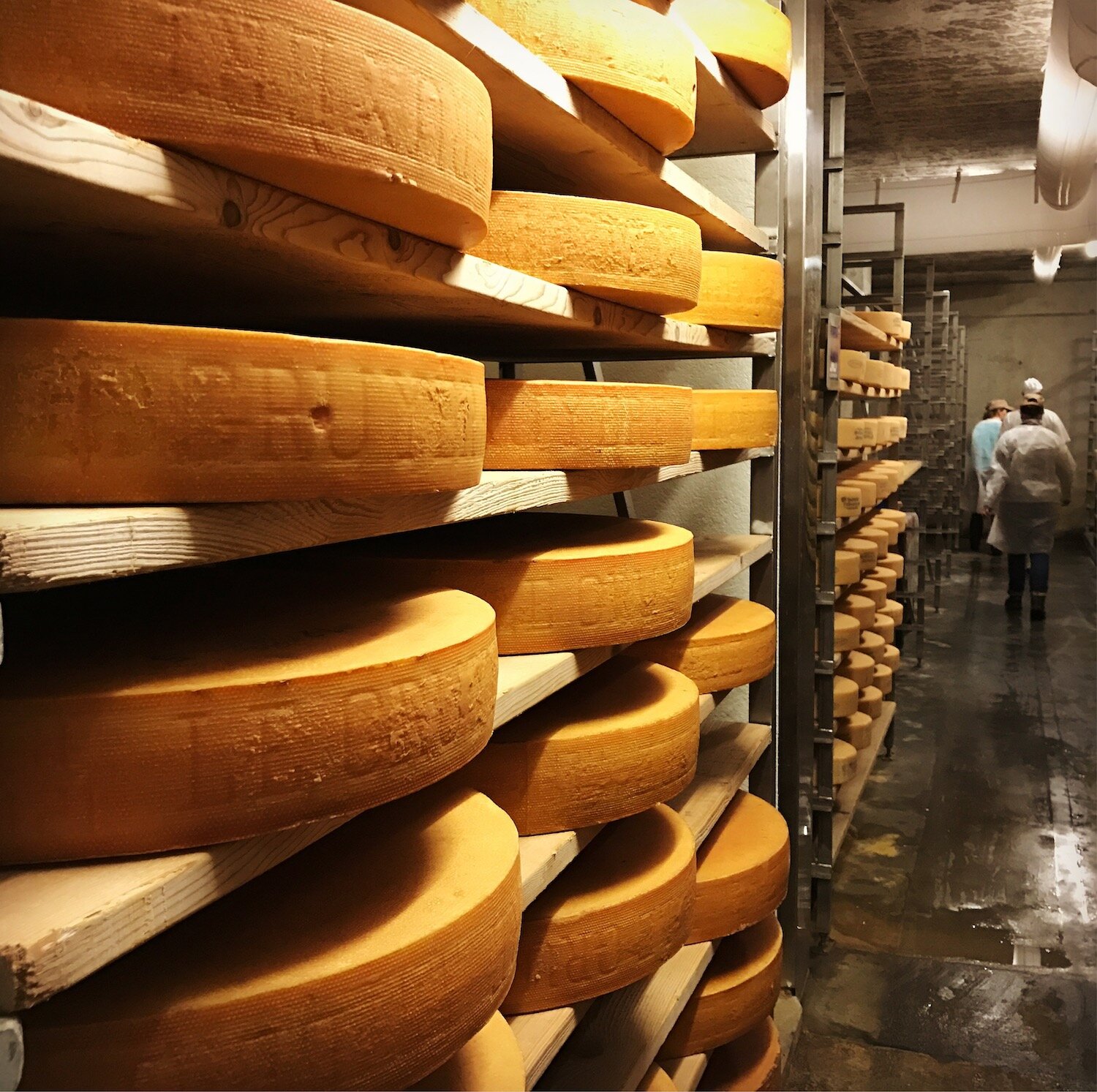A Tale of Two Cheeses: Le Gruyére d’Alpage AOP, and the Need to Define It
Five thousand feet up Alp Vounetz in the hulking, rugged mountains of Charmey, Switzerland, dairy farmer Béat Piller submerges his chest and arms into a large cauldron of nearly-scalding curds and whey. Bound to a recipe and techniques first written down over nine hundred years old, he will turn more than a hundred pounds of fresh curds into a wheel of Gruyère d'Alpage AOP by hand twice that day - all he is allowed by Swiss law. It's a back-breaking task that will take him the better part of eight hours.
Thirty miles away in the rolling green valley of Rueyres-Treyfayes, cheesemaker Vincent Gapany presses a button. One of two massive dairy tanks begins to automatically drain curds into an array of sophisticated cheese molds, the gleam of stainless steel reflecting the technology in the room. He will make fourteen wheels of Gruyère Village AOP over the next few hours that day, utilizing modernization to its fullest abilities.
Both are masters of their craft, making outstanding wheels of Switzerland's most famous product. Just don't ever call them the same cheese.
For Piller and Gapany alike, the guiding rules and regulations which inform their practices come from the Swiss appellation d’origine protégée system, known colloquially as the AOP. This classification system was created to define and protect the characteristics of culturally significant foods and beverages made in the country.
Gruyére is perhaps Switzerland’s most popular foodstuff to enjoy that protection, but it’s far from alone. Fellow cheeses Vacherin Mont d’Or, L’Etivaz, and Tête de Moine also benefit from the AOP system. The distilled fruit brandy eau de vie, wholemeal rye Roggenbrot, and the air-cured brick of raw beef, viande séchée,are covered as well. In total, 21 products are defined by the AOP system.
Switzerland isn’t the only country with this designation system, either. France’s appellation d'origine contrôlée (AOP) defines over 300 wines in addition to a whole slew of foods. Italy’s denominazione di origine controllata e garantita(DOCG) covers nearly 75 products across the country. Spain’s denominación de origen (DO) protects Iberian ham, cheese, vinegar, and other important products. Virtually every country in Europe has a system in place. Even the United States now classifies wines with the American Viticultural Area (AVA) designation.
All these classifications and their related governmental policies share the same goal - to protect the names and processes of unique and historically significant products, preserving their geographical origins, methods of production, and characteristics that define them. By recognizing each product as intellectual property, these systems help protect small producers and sometimes ancient and fragile production methods from counterfeiting and misrepresentations throughout the world.
Part of the responsibility of these systems is to clearly identify and define characteristics and processes specific to the product. This is especially important for products that may offer similar versions which may otherwise be conflated by the general consumer, to the detriment of all the producers involved.
Le Gruyére is an ideal example of a product with such a need for a clear distinction. This world-famous cheese is made in the canton of Fribourg, in western Switzerland. Of the versions made there, only one follows the exact methods of production and aging as when the recipe was first documented in the 12th century - Le Gruyére d’Alpage AOP.
Made only in higher altitudes, this cheese is not only uniquely styled among its brethren, it’s also a direct continuation of the region’s cheesemaking traditions from centuries ago. It’s the only version allowed to use the moniker “d’Alpage” and is required to use only feed found in the alpine pastures, handmade cheese-making techniques, and centuries-old materials to provide heat and storage.
To the average consumer, the distinction between those wheels made in the alps during the warmer months and valley wheels produced year-round may not be readily apparent or appreciated. While there are distinct differences in flavor and texture, they are both essentially cooked-curd alpine cheeses made from cow milk. A casual snacker may not notice, or even care to notice, the differences between them.
This is where the AOP system is critical. Switzerland’s proud tradition of cheesemaking is a cornerstone of their culinary heritage. Keeping Gruyére d’Alpage AOP’s methods exactly as they were when created so long ago is an important way to stay connected with the past. Without clearly defining what makes the cheese so unique and special, there is a real danger of imposters and bastardizations surfacing worldwide, thus diluting the cultural value it has held for centuries.
For producers like Piller and Gapany, and myriad others keeping important traditions alive wherever animal, man, and mountain meet, these systems of classification and the organizations which further and protect those interests are more than just global advocates. They are guardians of their past, present, and future.

